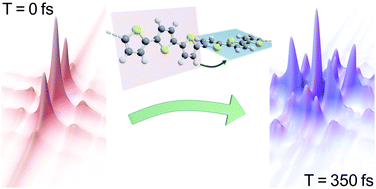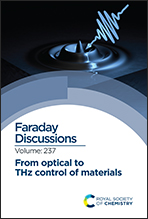Signatures of coherent vibronic exciton dynamics and conformational control in the two-dimensional electronic spectroscopy of conjugated polymers
Abstract
Two-dimensional electronic spectroscopy (2DES) signals for homo-oligomer J-aggregates are computed, with a focus on the role of structural change induced by low-frequency torsional modes, along with quasi-stationary trapping effects induced by high-frequency polaronic modes. To this end, a model system is derived from an ab initio parametrized site-based Hamiltonian for oligothiophenes [Binder et al., Phys. Rev. Lett., 2018, 120, 227401]. To obtain a compact representation, we introduce a collective lattice mode whose vibronic coupling depends nonlinearly on the exciton density. As a result, an N-site model with a single polaronic mode and a single torsional mode is obtained. Furthermore, a quantum–classical treatment is employed where the torsional mode is treated within a mean-field Ehrenfest/Langevin approximation. 2D electronic spectra are computed using the equation-of-motion phase-matching approach (EOM-PMA) within a wavefunction description. It is seen that the spectra combine the vibronic fine structure, due to the polaronic mode, and a dynamic Stokes shift, due to torsional relaxation. The signatures of the coherent effects and adiabatic evolution in the 2DES signals are discussed.

- This article is part of the themed collection: From optical to THz control of materials


 Please wait while we load your content...
Please wait while we load your content...